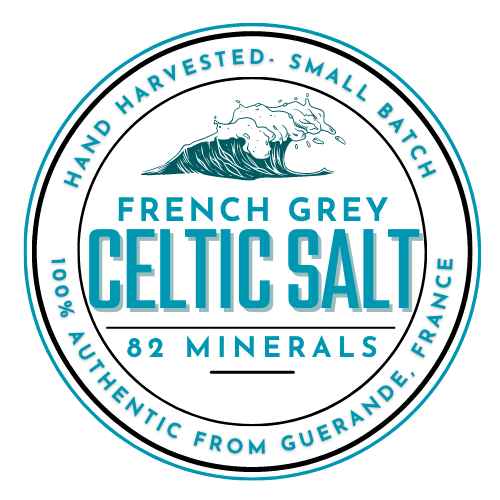
Celtic Salt: A Natural Treasure for Your Well-being and Palate
Step into the world of Celtic salt, a natural treasure that not only enhances the flavors of your favorite dishes but also brings a myriad of health benefits to your well-being. Derived from the pristine coastal regions of France, this unrefined salt is rich in essential minerals and trace elements that are vital for a balanced diet. Unlike its heavily processed counterparts, Celtic salt retains its natural moisture and mineral content, making it a healthier choice for your culinary endeavors. But its benefits don’t stop there.
Celtic salt is known for its ability to promote hydration, support proper digestion, and even improve respiratory health. Its unique flavor profile adds depth and complexity to every meal, taking your taste buds on a tantalizing journey. Explore the wonders of Celtic salt, and let its natural goodness transform both your palate and your overall wellness.
What makes Celtic Salt unique?Celtic salt stands out from other types of salt due to its unique characteristics. Unlike table salt, which undergoes extensive processing that strips away its natural minerals, Celtic salt is unrefined and retains its natural moisture and mineral content. This means that it not only adds flavor to your dishes but also provides essential nutrients that your body needs. Celtic salt is harvested from the coastal regions of France, where the pristine seawater is channeled into clay ponds to allow the sun and wind to naturally evaporate the water, leaving behind the salt crystals. This traditional method of production ensures that the salt retains its natural purity and goodness.
The history of Celtic salt dates back thousands of years. It has been used since ancient times by Celtic communities in Europe for both culinary and medicinal purposes. The Celtic people recognized the importance of salt in their diet and valued the unique properties of Celtic salt. They believed that Celtic salt had healing properties and used it to treat various ailments. Over time, the knowledge of Celtic salt spread, and its popularity grew beyond Celtic communities. Today, Celtic salt is enjoyed by people all over the world who appreciate its distinct flavor and health benefits.

Celtic salt can be used in various ways to elevate the flavors of your dishes. Here are a few suggestions on how to incorporate Celtic salt into your cooking:
1. Seasoning: Use Celtic salt as a replacement for table salt when seasoning your dishes. Its unique flavor profile will add depth and complexity to your meals.
2. Finishing salt: Sprinkle Celtic salt over your prepared dishes just before serving to add a final touch of flavor and texture.
3. Baking: Add a pinch of Celtic salt to your baked goods to enhance the sweetness and balance the flavors.
4. Brining: Use Celtic salt in brines to infuse your meats and vegetables with flavor and moisture.
5. Infused salts: Create your own flavored salts by combining Celtic salt with herbs, spices, or citrus zest. This allows you to customize the flavor profile according to your preferences.
1. Mediterranean Quinoa Salad:
– Ingredients:
– 1 cup cooked quinoa
– 1 cup cherry tomatoes, halved
– 1 cucumber, diced
– 1/4 cup Kalamata olives, pitted and halved
– 1/4 cup feta cheese, crumbled
– 2 tablespoons fresh lemon juice
– 2 tablespoons extra virgin olive oil
– 1 tablespoon fresh parsley, chopped
– Celtic salt, to taste
– Instructions:
1. In a large bowl, combine cooked quinoa, cherry tomatoes, cucumber, Kalamata olives, and feta cheese.
2. In a small bowl, whisk together lemon juice, olive oil, and parsley. Pour the dressing over the quinoa mixture and toss to combine.
3. Season with Celtic salt to taste. Serve chilled.
2. Pan-Seared Salmon with Lemon and Dill:
– Ingredients:
– 2 salmon fillets
– 2 tablespoons fresh lemon juice
– 1 tablespoon fresh dill, chopped
– Celtic salt, to taste
– 1 tablespoon olive oil
– Instructions:
1. Preheat a skillet over medium-high heat. Season the salmon fillets with Celtic salt on both sides.
2. In a small bowl, combine lemon juice and fresh dill. Drizzle the mixture over the salmon fillets.
3. Add olive oil to the preheated skillet. Place the salmon fillets skin-side down and cook for 4-5 minutes. Flip the fillets and cook for an additional 2-3 minutes, or until cooked to your desired doneness.
4. Serve the salmon with a squeeze of fresh lemon juice and garnish with additional dill.
While Celtic salt is a natural and environmentally friendly choice compared to heavily processed table salt, it’s important to consider the environmental impact of its production. The traditional method of harvesting Celtic salt involves evaporating seawater in clay ponds, which requires a significant amount of land and water resources. Additionally, the transportation of Celtic salt from the coastal regions of France to other parts of the world contributes to carbon emissions.
To mitigate the environmental impact, some salt producers are implementing sustainable practices. This includes using renewable energy sources for evaporation, optimizing water usage, and minimizing carbon emissions during transportation. When purchasing Celtic salt, look for brands that prioritize sustainability and support eco-friendly initiatives.
Conclusion: Incorporating Celtic Salt into your lifestyleCeltic salt is not just an ordinary seasoning; it’s a natural treasure that can enhance your well-being and palate. The unique characteristics of Celtic salt, including its rich mineral content and distinct flavor profile, make it a valuable addition to any kitchen. By incorporating Celtic salt into your cooking, you can elevate the flavors of your dishes while reaping the health benefits it offers. Whether you sprinkle it over your favorite meals, use it in baking, or experiment with infused salts, Celtic salt is sure to take your culinary creations to new heights. Embrace the wonders of Celtic salt and let its natural goodness transform both your palate and your overall wellness.



